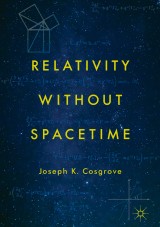Details

Relativity without Spacetime
|
106,99 € |
|
| Verlag: | Palgrave Macmillan |
| Format: | |
| Veröffentl.: | 23.05.2018 |
| ISBN/EAN: | 9783319726311 |
| Sprache: | englisch |
Dieses eBook enthält ein Wasserzeichen.
Beschreibungen
<p>In 1908, three years after Einstein first published his special theory of relativity, the mathematician Hermann Minkowski introduced his four-dimensional “spacetime” interpretation of the theory. Einstein initially dismissed Minkowski’s theory, remarking that “since the mathematicians have invaded the theory of relativity I do not understand it myself anymore.” Yet Minkowski’s theory soon found wide acceptance among physicists, including eventually Einstein himself, whose conversion to Minkowski’s way of thinking was engendered by the realization that he could profitably employ it for the formulation of his new theory of gravity. The validity of Minkowski’s mathematical “merging” of space and time has rarely been questioned by either physicists or philosophers since Einstein incorporated it into his theory of gravity. Physicists often employ Minkowski spacetime with little regard to the whether it provides a true account of the physical world as opposed to a useful mathematical tool in the theory of relativity. Philosophers sometimes treat the philosophy of space and time as if it were a mere appendix to Minkowski’s theory. In this critical study, Joseph Cosgrove subjects the concept of spacetime to a comprehensive examination and concludes that Einstein’s initial assessment of Minkowksi was essentially correct.</p><p><br></p>
<p><b><i>Introduction</i></b></p><p><b> </b>Chapter One: A Critique of Minkowski Spacetime</p><p><b><i>Part I: The Concept of Minkowski Spacetime</i></b></p><p> Chapter Two Minkowski’s “Space and Time”</p><p> 2.1 Minkowski and Göttingen Science</p><p> 2.2 “Space and Time,” Sections I and II</p><p> 2.3 “Space and Time,” Section III</p><p> 2.4 “Space and Time,” Section IV</p><p> Chapter Three Special Relativity and Spacetime</p><p> 3.1 The Concept of a Continuum</p><p> 3.2 The “Geometry of Spacetime”: Graphs and Images</p><p> 3.3 The Role of Invariance in Special Relativity</p><p> 3.3.1 Invariance and Frame-Independence</p><p> 3.3.2 Invariance and the Clock Paradox</p><p> 3.4 Transition to Part II: Conceptual Difficulties of Minkowski Spacetime and the Need for a Historical Approach</p><p><b><i>Part II: The Symbolic-Algebraic Constitution of the Concept of Spacetime </i></b></p><p> Introduction to Part II The Concept of a Sense-History</p><p> Chapter Four The Historical Sense-Structure of Symbolic Algebra</p><p> 4.1 The Concept of Number in Greek Mathematics</p><p> 4.1.1 Arithmetical Operations in Euclid</p><p> 4.1.2 The Concept of Ratio in Euclid</p><p> 4.1.3 Arithmetic and Geometry in Euclid</p><p> 4.2 Algebraic Equations in Greek Mathematics: Diophantus of Alexandria</p><p> 4.2.1 The Concept of Number in Diophantus</p><p> 4.2.2 Algebraic Calculations with “Species”</p><p> 3.3 Modern Symbolic Algebra</p><p> 4.3.1 Vieta’s Reinterpretation of Diophantine Species</p><p> 4.3.2 Vieta’s Law of Homogeneity and the Symbolic Concept of Number</p><p> 4.3.3 Vieta’s Algebra as <i>Mathesis Universalis</i></p><p><i> </i> 4.4 Descartes and Symbolic Space</p><p> 4.4.1 Geometrical Representation of Numerical Operations</p><p> 4.4.2 Symbolic Interpretation of Geometrical Magnitude</p><p> 4.4.3 Symbolic Space</p> Chapter Five The Historical Sense-Structure of Modern Algebraic Physics<p></p><p> 5.1 Pre-Algebraic Physics in Galileo</p><p> 5.2 The Assimilation of Algebra into Physics</p><p> 5.3 Case Study: Newton and Quantity of Motion</p><p> Chapter Six Desedimentation of Minkowski Spacetime</p><p><b><i>Part III General Relativity without Spacetime</i></b></p><p> Chapter Seven The Irrelevance of Minkowski Spacetime in General Relativity</p><p> 7.1 Tensor Calculus and “Geometrical Objects”</p><p> 7.1.1 Tensors as Ratio-Compounding Machines</p><p> 7.1.2 Tensors and Invariance</p><p> 7.2 Against the Longclothes: Minkowski Spacetime in Einstein’s 1916 Review Article</p> 7.2.1 Einstein 1916, Part A: “Fundamental Considerations on the Postulate of Relativity”<p></p><p> </p><p> 7.2.1.1 Part A, §2: The Principle of Equivalence</p><p> 7.2.1.2 Part A, §3: General Covariance</p><p> 7.2.1.3 Part A, §4: The “Linear Element”</p><p> 7.2.2 Einstein 1916, Part B: “Mathematical Aids to the Formulation of Generally Covariant Equations”</p><p> 7.2.2.1 Part B, §8: Fundamental Tensor </p><p> 7.2.2.2 Part B, §9: Mathematical Derivation of Geodesic Line</p> 7.2.2.3 Part B, §12: Riemann Tensor<p></p><p> 7.2.3 Einstein 1916, Part C: “Theory of the Gravitational Field”</p><p> 7.2.3.1 Part C, §13: Law of Motion</p><p> 7.2.3.2 Part C, §14: Vacuum Field Law</p><p> 7.2.3.3 Part C, §16: General Field Equation and Stress-Energy Tensor</p><p> 7.3. Geodesic Law by Other Means</p><p><b><i>Conclusion</i></b></p><p> Chapter Eight The Theory of Relativity in Philosophical Perspective</p><p> 8.1 Relativity and Time</p><p> 8.1.1 Simultaneity in Special Relativity</p><p> 8.1.2 Simultaneity in General Relativity</p> 8.1.3 Time and Becoming<p></p><p> 8.2 The Dynamical Approach to Relativity</p><p> 8.2.1 Brown on Bell’s “Lorentzian Pedagogy”: Single-Frame Lorentz Covariance</p><p> 8.2.2 Single-Frame Contraction, Acceleration, and Force</p><p> 8.2.3 Kinematics versus Dynamics</p><p> 8.2.4 Metrical Dynamics of Lorentz Contraction</p><p> </p><p> </p>
<p>Joseph K. Cosgrove is Associate Professor of Philosophy at Providence College in Rhode Island, USA.<br></p>
<div>In 1908, three years after Einstein first published his special theory of relativity, the mathematician Hermann Minkowski introduced his four-dimensional “spacetime” interpretation of the theory. Einstein initially dismissed Minkowski’s theory, remarking that “since the mathematicians have invaded the theory of relativity I do not understand it myself anymore.” Yet Minkowski’s theory soon found wide acceptance among physicists, including eventually Einstein himself, whose conversion to Minkowski’s way of thinking was engendered by the realization that he could profitably employ it for the formulation of his new theory of gravity. The validity of Minkowski’s mathematical “merging” of space and time has rarely been questioned by either physicists or philosophers since Einstein incorporated it into his theory of gravity. Physicists often employ Minkowski spacetime with little regard to the whether it provides a true account of the physical world as opposed to a useful mathematical tool in the theory of relativity. Philosophers sometimes treat the philosophy of space and time as if it were a mere appendix to Minkowski’s theory. In this critical study, Joseph Cosgrove subjects the concept of spacetime to a comprehensive examination and concludes that Einstein’s initial assessment of Minkowksi was essentially correct.</div><div><br></div>
<p>One of the first critical studies on the theory of geometrically merged space and time in Einstein's theory of relativity</p><p>Analyzes mathematical representation in physics historically</p><p>Applies Jacob Klein's seminal scholarship on the modern symbolic concept of number to a theory of physics</p>

















